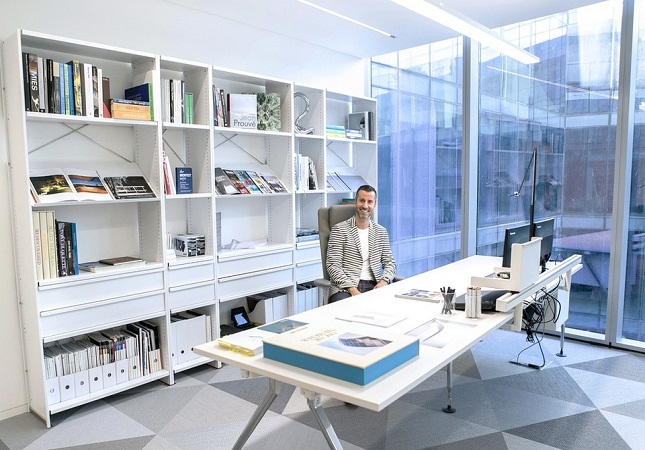
Viktor Udzenija was supposed to be the first to officially open offices in the new Dubai Design District, but he says he let his architectural instincts get the better of him.
“The entry door to the office was too near the toilets. I didn’t want clients to have to see someone zipping up their pants as they came in,” Mr Udzenija explains, so the decision to have the entry door ripped out and moved to the other end of the office space meant that Christian Dior pipped him to the honour of being the first at “D3” to officially cut the ribbon.
With the exception of Mr Udzenija’s firm, Dior and a handful of others, the new complex on the southern edge of the city can hardly be considered fully complete.
Workers and building machinery are still dominating the space and most of its cluster of buildings sport heavy tape on the windows and await finishing touches before they can start being occupied.
Mr Udzenija laments the fact that there isn’t even a coffee shop – “someone could make a killing” – in his building No 8, which is the most finished of the dozen initial units.
But D3 is part of Dubai’s series of long-term initiatives – including the highly successful Design Days Dubai – that city authorities have undertaken to foster the creative industries and make the city a regional, if not a global, centre for design talent and business.
The tenants will include Mr Udzenija’s old firm, the world- renowned architectural firm Foster + Partners, where he cut his teeth straight out of Technical University of Munich, working for the legendary Sir Norman Foster in the firm’s London headquarters on the south bank of the River Thames.
Mr Udzenija, a Czech national who bears a striking resemblance to the Serb tennis star Novak Djokovic, says he started out at Foster as part of a London-based team concentrating primarily on projects in the Middle East.
He moved to Dubai to work on some of the firm’s major building projects, including The Index in the Dubai International Financial Centre, an 80-storey office and residential tower that a non-architect might describe as looking like a giant radiator.
The Index project ran from 2005 until 2011.
“I was supposed to be here a year but then the financial crisis hit and there were struggles to get things done and the project took three years to finish,” says Mr Udzenija.
“Meanwhile, I fell in love with Dubai and I decided midway through the crisis to set up my own studio, concentrating on interior projects initially, then bigger properties, major penthouses, residences.”
Mr Udzenija shares a design sensibility that seems to be taking hold among young creatives in Dubai: they see the fact that there is little real design heritage here as freeing, and leaving the way open to invent their own.
There is also a huge opportunity for ambitious Dubai-based architects to forge their reputations. “Dubai has a lack of established international architects,” he says. “People so far have not been very appreciative of the job of the architect, especially in the residential market.”
That there is no urban planning council but rather just municipal rules to overcome, which has had its upside and downside for Dubai’s skyline: “It has meant that Dubai has been able to build what it has in such a short period of time – the Burj Khalifa. But there have been some less successful buildings too,” says Mr Udzenija, adding that Dubai has been developed in a somewhat haphazard fashion, with a huge highway running down the centre of a number of disconnected parts, such as the marina and Bur Dubai
 Comments ( 0 )
Comments ( 0 )
 Post a Comment
Post a Comment